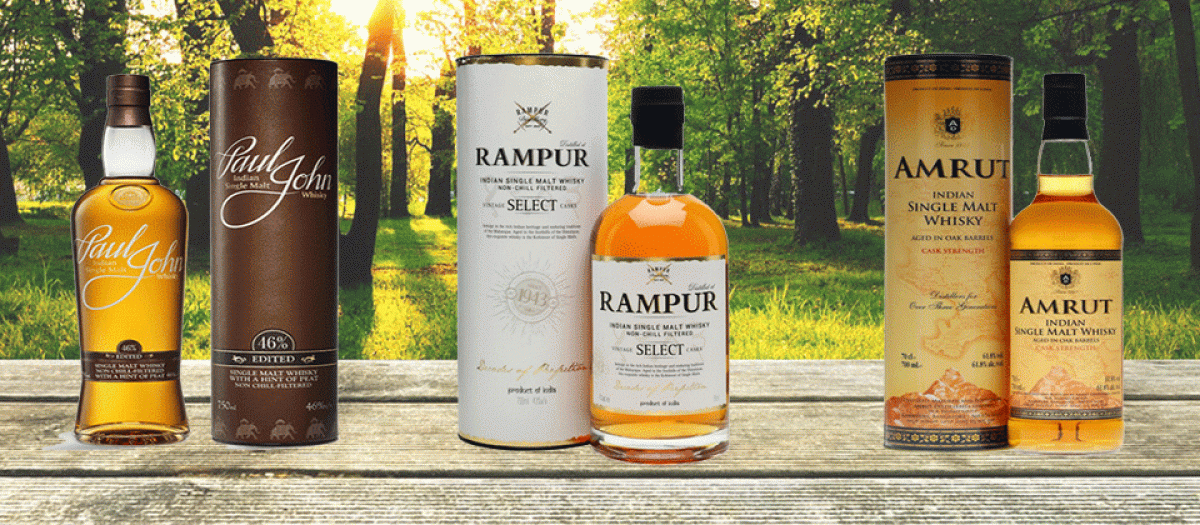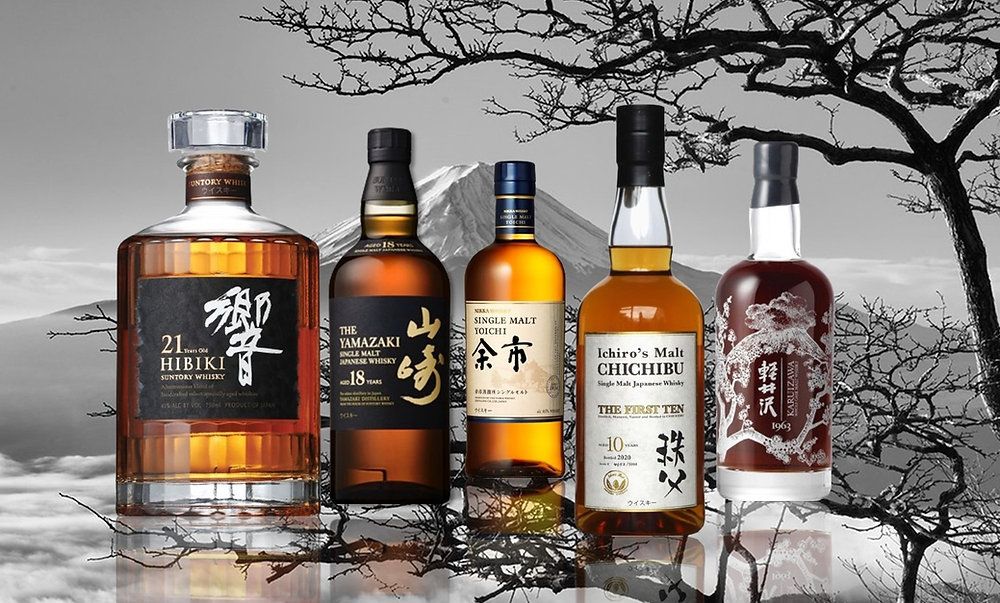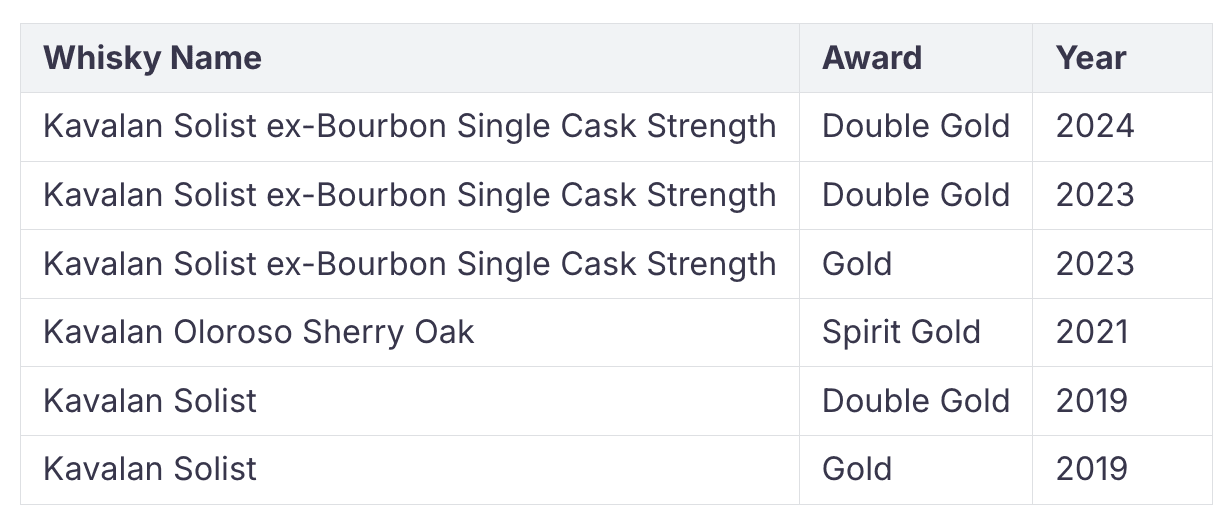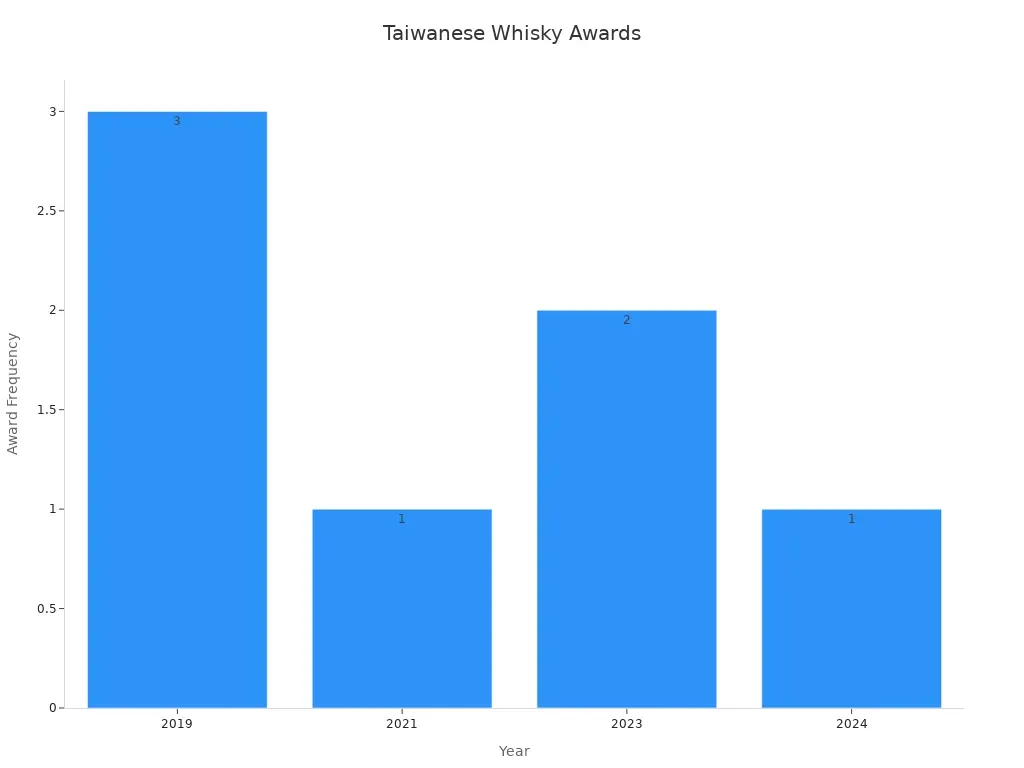18.06.2025
Indian Whisky vs Japanese Whisky vs Taiwanese Whisky: Which Reigns Supreme?

Indian Whisky vs Japanese Whisky vs Taiwanese Whisky: Which Reigns Supreme?
When it comes to whiskies from Asia, you’re in for a treat. Indian whisky grabs your attention with bold flavors that feel like an adventure for your taste buds. Japanese whisky, on the other hand, takes you on a journey of precision, where every sip reflects artistry and care. Then there’s Taiwanese whisky, standing out with its fresh ideas and a reputation that’s grown faster than you might expect. It’s not about which is better—it’s about what speaks to your palate. Each one has a story worth savoring.
Key Takeaways
-
Indian whisky has strong flavors and special tastes. It uses six-row barley and ages faster in warm weather.
-
Japanese whisky is famous for its skillful making and balance. It has light flavors and is smooth to drink.
-
Taiwanese whisky is different with new methods and fruity flavors. It’s a fun and fresh choice for whisky fans.
-
India, Japan, and Taiwan each add their own culture and style to whisky, making it more interesting worldwide.
-
Trying Asian whiskies can teach you about new flavors. They offer many tastes and ideas that are different from usual whisky.
Indian Whisky

Flavor Profiles
Indian whisky offers bold and vibrant flavors that stand out in the global whisky scene. You’ll often notice a rich mix of spices, dried fruits, and hints of oak in every sip. This distinct character comes from the use of six-row barley, which is unique to Indian whisky. Unlike the two-row barley used in Scotch, six-row barley adds a spicy kick and a fuller body to the drink. The tropical climate in India also plays a role, accelerating the aging process and creating whiskies with intense, concentrated flavors. Whether you prefer a smoky finish or a sweeter profile, Indian whisky has something to match your taste.
Production Techniques
The production of Indian whisky draws inspiration from Scotch whisky-making traditions but adds its own twist. For starters, Indian distillers often use six-row barley, which gives the whisky its signature spicy notes. The tropical climate speeds up the maturation process, meaning whiskies age faster in India than in cooler regions like Scotland. This results in a unique flavor profile that’s hard to replicate elsewhere. Additionally, many Indian single malts are crafted with meticulous attention to detail, ensuring high quality. These techniques have helped Indian whisky gain recognition on the global stage.
-
Key production highlights:
-
Influenced by Scotch whisky laws.
-
Use of six-row barley for a spicier flavor.
-
Faster aging due to India’s tropical climate.
-
Leading Brands
Indian whisky dominates the global market in terms of volume, with several brands achieving international acclaim. McDowell’s No. 1, produced by United Breweries, is the best-selling whisky globally. Other popular names include Royal Stag and Imperial Blue, both of which are part of the Pernod Ricard Group. These brands have carved out a significant share in the whisky market, not just in India but worldwide.

India’s whisky industry continues to grow, with its bold flavors and innovative techniques capturing the attention of whisky lovers everywhere.
Global Recognition
Indian whisky has made waves on the global stage, earning respect and admiration from whisky enthusiasts and critics alike. You might be surprised to learn just how many international awards these whiskies have racked up. They’ve proven that quality and innovation can thrive outside traditional whisky-producing nations.
Take Amrut Fusion, for example. This single malt has become a shining star, often referred to as the "crown jewel" of Indian whiskies. It has bagged over 40 accolades worldwide, including five gold medals at the International Spirits Competition. That’s no small feat! Amrut Distilleries has also been celebrated for its creativity and commitment to quality, cementing its place among the world’s best.
Another standout is Indri Single Malt Whisky. This brand has been turning heads with its impressive achievements. Indri won the prestigious "Whisky of the Year" award at the International Whisky Competition. Its Founder’s Reserve 11-Year-Old Wine Cask edition was also ranked among the "Top 15 Whiskies of the Year." And if that wasn’t enough, Indri Dru earned a gold medal at Meininger’s International Spirit Award in Germany. The brand even secured top honors at the Tokyo Whisky and Spirits Competition and the San Francisco World Spirits Competition.
These accolades highlight the growing recognition of Indian whisky on the international stage. They show that Indian distilleries are not just keeping up with global standards—they’re setting new ones. So, the next time you pour yourself a glass of Indian whisky, remember that you’re sipping on something truly world-class.
Japanese Whisky

Craftsmanship and Flavor
Japanese whisky is all about balance and precision. Every bottle reflects a deep commitment to craftsmanship. You’ll notice delicate flavors that are often floral, fruity, and even umami. These subtle notes make Japanese whisky stand out from bolder styles like Scotch, which often leans toward smoky and peaty profiles.
Take Hibiki Japanese Harmony, for example. This whisky is a masterclass in blending. It combines whiskies from three distilleries to create a drink that’s smooth, silky, and perfectly balanced. Floral hints, honey sweetness, and a touch of spice come together in harmony. It’s not just a drink—it’s an experience. The Japanese approach prioritizes subtlety and integration, showcasing the artistry behind every sip.
“Japanese whisky is like a symphony—every note plays its part to create something extraordinary.”
Historical Influences
Japanese whisky has a fascinating history. It all began in the late 19th century when Western liquors, including whisky, started gaining popularity in Japan. By the 1920s, Shinjiro Torii opened the Yamazaki distillery, Japan’s first whisky distillery. He was joined by Masataka Taketsuru, who had studied distillation techniques in Scotland. Together, they laid the foundation for Japanese whisky as we know it today.
During the 1960s and 1970s, whisky became a staple in Japanese culture. It was no longer seen as a foreign import but as a domestic favorite. By the early 2000s, Japanese whiskies began winning international awards, cementing their place on the global stage.
Iconic Brands
When it comes to Japanese whisky, a few brands truly shine. Suntory leads the pack with its iconic Yamazaki 12, a whisky that’s loved worldwide. Nikka, founded by Masataka Taketsuru, is another standout. Its single malts and blends are known for their exceptional quality. Then there’s Chichibu, a smaller distillery that’s making waves with its innovative methods, like using Mizunara oak fermentation tanks to create unique fruity flavors.
If you’re exploring Japanese whisky, these brands are a great place to start. Each one offers a taste of the craftsmanship and passion that define this remarkable spirit.
International Awards
Japanese whisky has earned its place among the world’s finest, and the awards prove it. You’ll find these whiskies consistently topping international competitions, showcasing their unmatched craftsmanship and flavor.
Here’s a quick look at some of the most prestigious accolades Japanese whisky has snagged:
-
World Whiskies Awards (WWA):
The Yamazaki Single Malt Sherry Cask 2013 was crowned "World’s Best Single Malt" in 2015. This win put Japanese whisky on the global map and made it a must-try for whisky lovers everywhere. -
International Spirits Challenge (ISC):
Suntory’s Hibiki 21-Year-Old has won multiple gold medals at the ISC. Its complex yet harmonious flavor profile continues to impress judges year after year. -
San Francisco World Spirits Competition (SFWSC):
Nikka’s Taketsuru Pure Malt has bagged double gold medals at this prestigious event. Its smooth blend of malt whiskies makes it a standout choice for connoisseurs.
Did you know?
Japanese whisky’s rise to fame started with its first major win at the WWA in 2001. Since then, it hasn’t looked back!

These awards aren’t just trophies—they’re proof of the dedication and artistry behind Japanese whisky. When you sip on a glass of Yamazaki or Hibiki, you’re tasting a spirit that has wowed experts worldwide.
So, if you’re looking for a whisky that’s both elegant and internationally celebrated, Japanese whisky is your answer. It’s not just a drink; it’s a masterpiece.
Taiwanese Whisky
Distinctive Taste
Taiwanese whisky brings a unique flavor profile to the table. You’ll notice rich, bold notes that stand out from whiskies produced in cooler climates. The subtropical weather in Taiwan plays a big role here. High humidity and stable temperatures speed up the maturation process, creating whiskies with intense flavors and concentrated aromas. This accelerated aging also leads to a higher Angels’ Share, giving the whisky a depth that’s hard to match.
When you sip on Taiwanese whisky, you might pick up fruity hints, creamy textures, and even a touch of tropical sweetness. Kavalan, Taiwan’s most famous distillery, is known for crafting whiskies that feel like a burst of sunshine in your glass. Whether you’re a fan of bold or delicate flavors, Taiwanese whisky offers something exciting for your palate.
Innovative Methods
Taiwanese distilleries don’t just follow tradition—they innovate. Kavalan Distillery, for example, has revolutionized whisky-making with techniques like the STR process. This method removes unwanted flavors from wine casks while enhancing fruity notes, resulting in whiskies that are vibrant and well-rounded.
Master distiller Ian Chang has also pushed boundaries by using wine casks from prestigious French estates for maturation. This approach adds layers of complexity and elegance to Kavalan’s whiskies. The subtropical climate further amplifies these innovations, allowing distillers to experiment with shorter aging periods while still achieving remarkable depth and character.
Taiwan’s whisky industry thrives on creativity and quality. Every bottle reflects a commitment to pushing the boundaries of what whisky can be.
Prominent Brands
When it comes to Taiwanese whisky, Kavalan is the name you’ll hear most often. This distillery has taken the world by storm with its award-winning creations. Kavalan Solist Vinho Barrique, for instance, won "World’s Best Single Malt" at the World Whiskies Awards. Its rich, fruity profile and velvety texture make it a favorite among whisky lovers.
Another standout is Omar Whisky, produced by the Nantou Distillery. Omar offers a range of single malts that showcase Taiwan’s unique climate and innovative techniques. From sherry cask finishes to bourbon-aged expressions, Omar delivers whiskies that are both approachable and complex.

Taiwanese whisky may be a newcomer, but it’s already making waves. If you’re looking for something fresh and exciting, these brands are worth exploring.
Global Acclaim
Taiwanese whisky has taken the world by storm, earning accolades that rival the best from traditional whisky-producing nations. If you’ve ever wondered how a relatively new player could make such a splash, the answer lies in its bold flavors, innovative techniques, and a knack for impressing international judges.
Kavalan, Taiwan’s most celebrated distillery, has become a global sensation. Its whiskies consistently win top honors at prestigious competitions. For instance, the Kavalan Solist ex-Bourbon Single Cask Strength has bagged Double Gold at the San Francisco World Spirits Competition (SFWSC) in both 2024 and 2023. It also earned a Gold at The World Whisky Masters in 2023 and a Spirit Gold Outstanding at the International Wine & Spirit Competition (IWSC) in 2019. These awards highlight Kavalan’s ability to craft whiskies that captivate both the palate and the imagination.
Here’s a quick look at some of Kavalan’s most notable achievements:

Did you know?
Taiwanese whisky’s rapid rise to fame is partly due to its subtropical climate, which accelerates aging and creates rich, complex flavors that wow judges worldwide.
To visualize just how much Taiwanese whisky has achieved, take a look at this chart showing the yearly count of international awards:

These awards aren’t just trophies—they’re proof of Taiwan’s dedication to quality and innovation. When you sip on a glass of Kavalan, you’re tasting a whisky that has earned its place among the world’s finest. So, if you’re looking for a spirit that’s both groundbreaking and globally celebrated, Taiwanese whisky deserves your attention.
Comparative Analysis
Taste and Flavor
When it comes to taste, each whisky region offers something unique. Indian whisky often delivers bold, spicy flavors with hints of dried fruits and oak. The tropical climate in India speeds up the aging process, resulting in whiskies with intense, concentrated profiles. If you enjoy a robust and adventurous sip, Indian whisky might be your go-to.
Japanese whisky, on the other hand, is all about balance and subtlety. You’ll find floral and fruity notes, often accompanied by a touch of umami. These whiskies are crafted to be smooth and harmonious, making them perfect for those who appreciate a refined and delicate flavor.
Taiwanese malt whisky stands out with its rich and vibrant taste. The subtropical climate in Taiwan creates whiskies with bold fruity notes, creamy textures, and a hint of tropical sweetness. Kavalan’s whiskies, for example, feel like a burst of sunshine in your glass. Whether you prefer bold or delicate flavors, there’s an Asian whisky that matches your palate.
Tip: If you’re new to whisky, start with Japanese whiskies for their smoothness. For a more adventurous experience, explore Indian or Taiwanese options.
Craftsmanship and Techniques
The craftsmanship behind these whiskies is as diverse as their flavors. Indian whisky combines traditional Scotch methods with local innovations. Distillers use six-row barley and embrace the tropical climate to create whiskies that age faster and develop unique spicy notes. Brands like Amrut and Paul John have mastered this art, producing world-class whiskies that reflect India’s diverse climate and ingredients.
Japanese whisky takes inspiration from Scotland but adds its own twist. Distillers often use Mizunara oak casks, which impart unique flavors like sandalwood and coconut. The meticulous blending process ensures every bottle achieves a perfect balance. This attention to detail has made Japanese whisky a global favorite.
Taiwanese whisky, particularly from Kavalan, is all about innovation. Techniques like the STR (Shave, Toast, Rechar) process enhance fruity notes while removing unwanted flavors. The subtropical climate allows for shorter aging periods without compromising depth and complexity. This creative approach has helped Taiwanese whisky gain rapid global recognition.

Cultural and Historical Significance
The cultural and historical roots of these whiskies add another layer of richness. Indian whisky reflects the country’s diverse climate and local ingredients. Brands like Amrut and Paul John have embraced these elements, creating whiskies that are uniquely Indian while appealing to global tastes.
Japanese whisky has a fascinating history. It began with Shinjiro Torii and Masataka Taketsuru, who brought Scotch techniques to Japan in the early 20th century. Over time, Japanese distillers added their own cultural influences, such as using Mizunara oak, to create a distinct style. This blend of tradition and innovation has made Japanese whisky a symbol of precision and artistry.
Taiwanese whisky, though newer, has quickly made its mark. Kavalan distillery exemplifies the use of local ingredients and innovative processes. Its success highlights Taiwan’s ability to compete with traditional whisky-producing nations.
-
Key cultural influences:
-
India: Innovative aging techniques influenced by the tropical climate.
-
Japan: A blend of Scotch methods and unique elements like Mizunara oak.
-
Taiwan: Local ingredients and creative processes driving global recognition.
-
Did you know? The rise of Asian whiskies has reshaped the global whisky market, challenging traditional producers and showcasing the diversity of flavors and techniques.
Market Impact
Asian whiskies have reshaped the global whisky market, and you’ve probably noticed their growing presence on store shelves and menus. Indian, Japanese, and Taiwanese whiskies aren’t just competing with traditional producers—they’re thriving. Let’s dive into how these whiskies are making waves in the market.
Indian Whisky: Volume and Accessibility
Indian whisky dominates the global market in terms of sheer volume. Brands like McDowell’s No. 1 and Royal Stag sell millions of cases annually, making India one of the largest whisky producers in the world. If you’re looking for affordability without compromising on flavor, Indian whisky is often the go-to choice.
Here’s why Indian whisky stands out:
-
Mass Appeal: Indian whiskies cater to a wide audience, offering bold flavors at accessible prices.
-
Export Growth: Indian whisky exports have surged in recent years, especially to markets like the UK and the US.
-
Market Share: India accounts for nearly half of the global whisky consumption, thanks to its massive domestic market.
Fun Fact: India consumes more whisky than any other country, with over 1.5 billion liters consumed annually. That’s almost half the world’s whisky!
Japanese Whisky: Prestige and Exclusivity
Japanese whisky has carved out a niche as a luxury product and is well know for it's exceptional craftsmanship. You’ll often find these whiskies in high-end bars and specialty stores. Their reputation for quality and craftsmanship has made them a favorite among collectors and connoisseurs.
What drives Japanese whisky’s market impact?
-
Premium Pricing: Japanese whiskies often come with a higher price tag, reflecting their meticulous production methods.
-
Limited Editions: Brands like Yamazaki and Hibiki release limited editions that sell out quickly, creating a sense of exclusivity.
-
Global Demand: Exports have skyrocketed, with the US and Europe being major markets.

Tip: If you’re looking to invest in whisky, Japanese brands like Yamazaki and Nikka are worth considering. Their limited editions often appreciate in value over time.
Taiwanese Whisky: Innovation and Rapid Growth
Taiwanese whisky is the new kid on the block, but it’s already making a big splash. Kavalan, the flagship brand, has gained international acclaim, and its success has boosted Taiwan’s reputation as a serious whisky producer.
Here’s how Taiwanese whisky is impacting the market:
-
Global Recognition: Awards and accolades have put Taiwanese whisky on the map, attracting attention from whisky enthusiasts worldwide.
-
Export Expansion: Kavalan exports to over 60 countries, with strong demand in Europe and Asia.
-
Consumer Appeal: Innovative flavors and bold profiles make Taiwanese whisky a favorite among younger drinkers.
Did you know? Kavalan’s Solist Vinho Barrique was named "World’s Best Single Malt" at the World Whiskies Awards, beating out competitors from Scotland and Japan.
The Bigger Picture
Asian whiskies have collectively challenged the dominance of traditional producers like Scotland and Ireland. They’ve introduced new flavors, techniques, and cultural influences to the market, enriching the global whisky landscape.
Here’s what you’re seeing in the market:
-
Diversification: Consumers now have access to a wider range of whiskies, from bold Indian malts to delicate Japanese blends and innovative Taiwanese creations.
-
Economic Impact: Whisky exports contribute significantly to the economies of India, Japan, and Taiwan, creating jobs and boosting tourism.
-
Changing Trends: Younger drinkers are exploring Asian whiskies, drawn by their unique flavors and stories.
Takeaway: Whether you’re a seasoned whisky lover or just starting your journey, Asian whiskies offer something fresh and exciting. They’re not just drinks—they’re experiences that reflect the rich cultures and craftsmanship of their origins.
When it comes to Asian whiskies, you’re spoiled for choice. Indian whiskies bring bold flavors and a sense of adventure. Japanese whiskies charm you with their precision and artistry. Taiwanese whiskies surprise you with their innovation and vibrant taste. Each one offers something special, making it impossible to pick a single winner.
Ultimately, the best whisky depends on your personal taste. Whether you prefer bold, balanced, or experimental, these whiskies showcase the exceptional quality coming out of Asia. Together, they’re reshaping the global whisky scene and proving that tradition isn’t the only path to greatness.
FAQ
What makes Asian whiskies different from Scotch or Bourbon?
Asian whiskies stand out due to their unique climates, ingredients, and techniques. For example, Indian whiskies age faster in tropical heat, Japanese whiskies focus on balance and precision, and Taiwanese whiskies innovate with bold flavors. Each offers a distinct experience you won’t find in Scotch or Bourbon.
Are Asian whiskies suitable for beginners?
Absolutely! Japanese whiskies, with their smooth and balanced profiles, are perfect for beginners. If you’re feeling adventurous, try Indian whiskies for their bold flavors or Taiwanese whiskies for their vibrant, fruity notes. There’s something for every palate.
Why is Japanese whisky so expensive?
Japanese whisky often comes with a higher price tag due to its meticulous craftsmanship, limited production, and global demand. Many brands release small-batch or aged whiskies, which adds to their exclusivity. Think of it as paying for artistry in a bottle.
Can you age whisky faster in tropical climates?
Yes! Tropical climates, like those in India and Taiwan, speed up the aging process. The higher temperatures and humidity intensify the interaction between the whisky and the barrel, creating rich and complex flavors in a shorter time. It’s like nature’s fast-forward button for whisky.
Which Asian whisky should I try first?
If you’re new, start with a Japanese classic like Hibiki Harmony for its smoothness. For bold flavors, go for Amrut Fusion from India. Feeling adventurous? Kavalan Solist from Taiwan offers a vibrant, tropical twist. Each sip is a journey worth taking!
Tip: Explore tasting sets to sample different styles before committing to a full bottle.
About the author

Janis Wilczura
I started my Whisky journey like many others - I have had a friend who was already into it. After some time in Montreal I moved to Munich in 2015 where I met one of my best friends Ferdinand who was passionate about Whisky already and shared his enthusiasm with me. I fell in love with this product and today I can say that Whisky is more for me than just "Alcohol" it's craftmanship, art and truly something special. Over the course of the past years I have managed to become one of the leading experts in Whisky in Germany featuring articles ar BILD.de, Handelsblatt, Sueddeutsche, Playboy, Business Punk and many more.
To the author